THE EXPLOITATION OF THE SEABED, A NEW SELF-DESTRUCTIVE LIMIT FOR HUMANITY
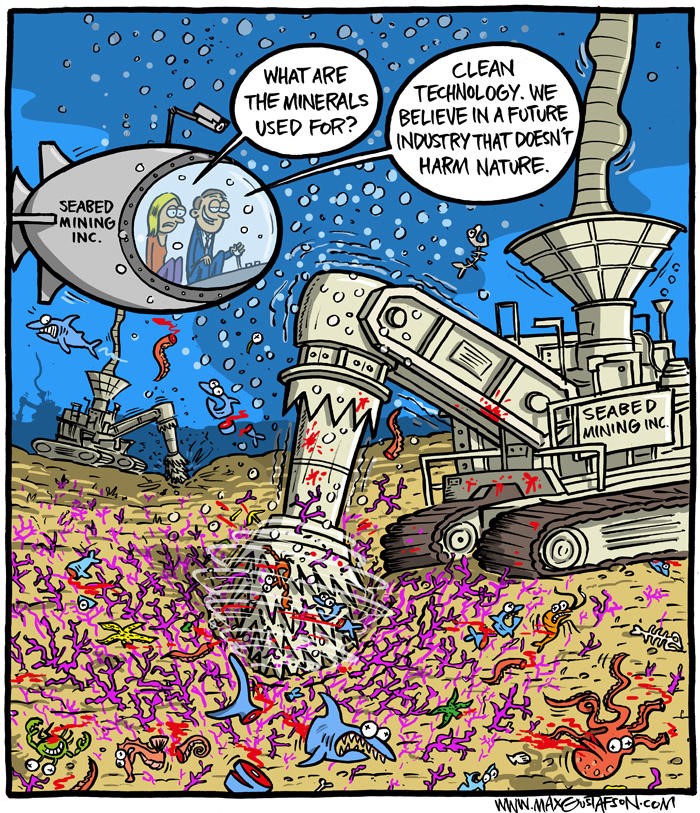
In one of his extremely successful novels, “The Swarm”, published in 2004, the German writer Frank Schätzing tells how the exploitation of the seabed irreparably changes not only the flora and fauna of the abyss, but also the balance of tectonics of the planet. Indeed, the continental shelves resist the pressures of the land and the oceans thanks to a delicate geological balance which, as the novel tells us, if it is destroyed, has a consequence: the continents collapse, dissolve and are sucked up into the sea.
Schätzing’s bestseller tells an apocalyptic story, but also scientifically shows what would happen if someone or something played with the seabed: the Norwegian coast disappears between the waves, dragging down streets, towns, people and entire fjords in minutes. In short, this book warns humanity not to play with what seems to be the ultimate frontier of our madness: the idea of using the ocean floor to extract oil or minerals[1].
In the meantime, this nightmare has become a reality. At present, massive mining projects are carried out in offshore waters by mines and geological institutes of various nations at the bottom of the Indian Ocean. These projects are organized under the auspices of a Jamaican company, the International Seabed Authority (ISA), which was founded in 1994 as a possible United Nations agency, then transformed into an independent company, which retains the power to issue mining licenses in offshore waters. The ISA has adopted a structure that (apparently) replicates the UN agency’s assembly, but rather acts as a true industry council and political broker – based on a barely transparent structure that hides all sensitive information behind the curtain of diplomatic secrecy[2].
The limits of the exploitation of the earth’s crust
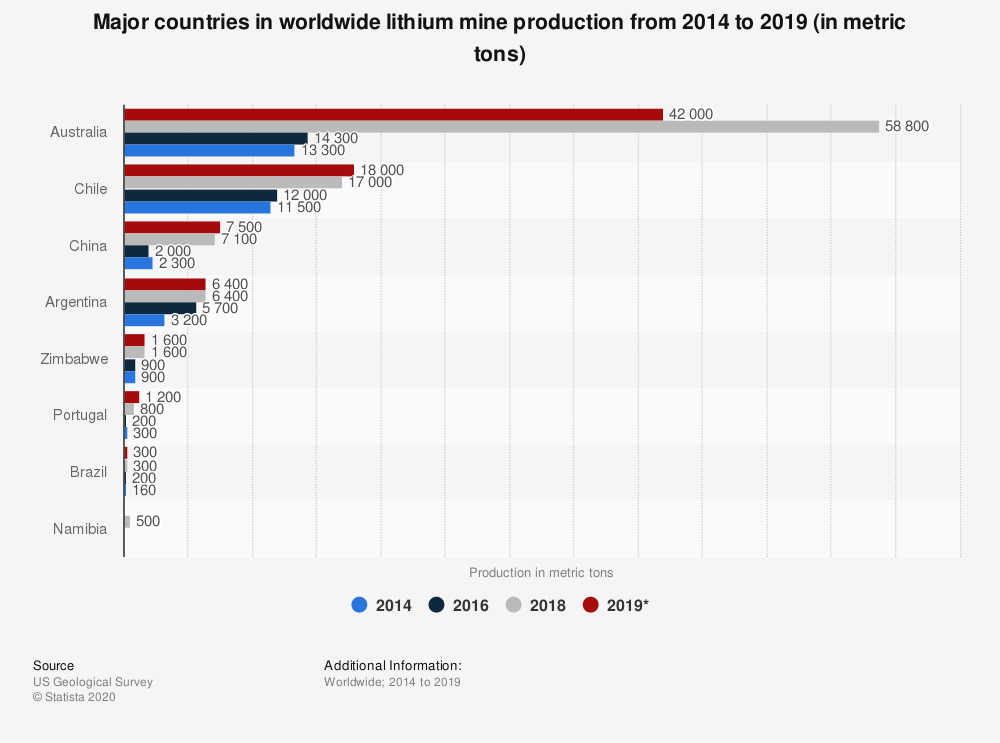
Global lithium production in 2019[3]
With the expansion of the electronics market, the demand for lithium and other necessary raw materials has accelerated exponentially for years. Then there is a sector which is expected to experience strong growth in the near future and which will weigh heavily on the demand for basic materials, that of the electric car, and which will soon reach unprecedented figures in the world. This emerging supply chain is expected to produce more than 340 million electric vehicles (from passenger cars to trucks to buses[4]) by 2030.
The construction of accumulators will require a sharp increase in the production of scarce raw materials, which will force suppliers to rethink their strategies. We have serious problems of adapting raw material technologies: due to environmental constraints and the lack of specialized numbers for the conversion of raw material technologies, most areas risk losing the game, either because these raw materials are too expensive[5] or because they are environmentally harmful[6].
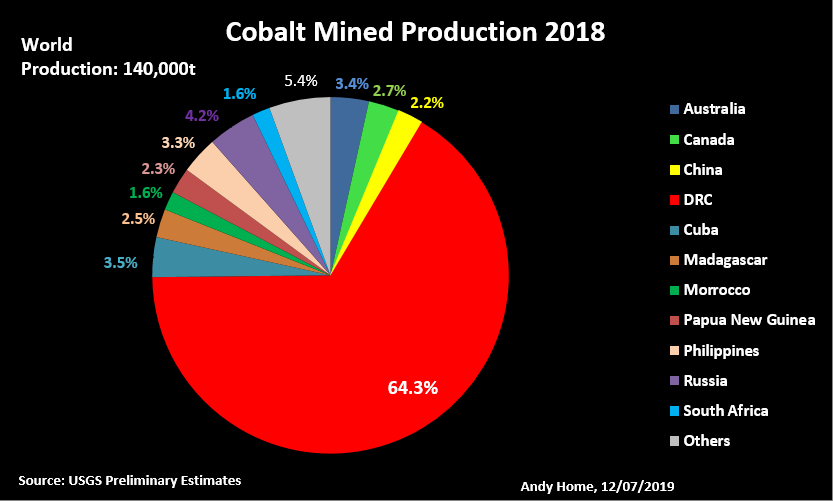
World cobalt production in 2018[7]
For example, as the latest UNCDAT (United Nations Conference on Trade and Development[8]) report shows, nearly 50% of the world’s sources of cobalt are found in the Democratic Republic of the Congo, 58% of the lithium used in the world comes from Chile and 80% of natural graphite reserves are in China, Brazil and Turkey, while 75% of manganese reserves come from Australia, Brazil, South Africa and Ukraine – and come from mines and countries in deep economic crisis or working against the law or are at the end of their production period[9].
For the manufacture of auto-accumulators, it will soon be necessary to use quantities of nickel, manganese and cobalt never known before. The fact that very high concentrations of raw material activities, less elements such as lithium ions, are the prerogative of a single country (Australia, China, Chile and Argentina[10]) determines the serious political and military tension of entire continents[11] and poses a strong geopolitical risk[12].
But it’s not just the car and electronics market that is driving the mining industry’s interest in rare metals. In 2018, the US Geological Survey identified 35 essential minerals for the economy and national security and therefore for productions of military interest[13]: drones, missiles, target sensors, radar, stealth technology, lasers, microwave weapons (ADS[14]), jamming technology and much more[15]. And here we are obviously entering an extremely dense universe whose interests go far beyond those of the traditional market, so that not only mining companies but also arms factories like Lockheed-Martin are focusing on exploitation of the seabed[16].
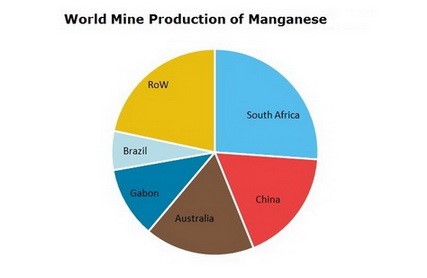
Percentage of world manganese production in 2020[17]
Unfortunately, resources may not be sufficient to meet industry demands in the near future. Rough estimates assume that nature reserves will not last more than 20 years. This does not necessarily mean the actual depletion of the elements, but a gradual increase in the difficulties of extraction techniques and the costs of extraction and storage[18].
History of seabed degradation
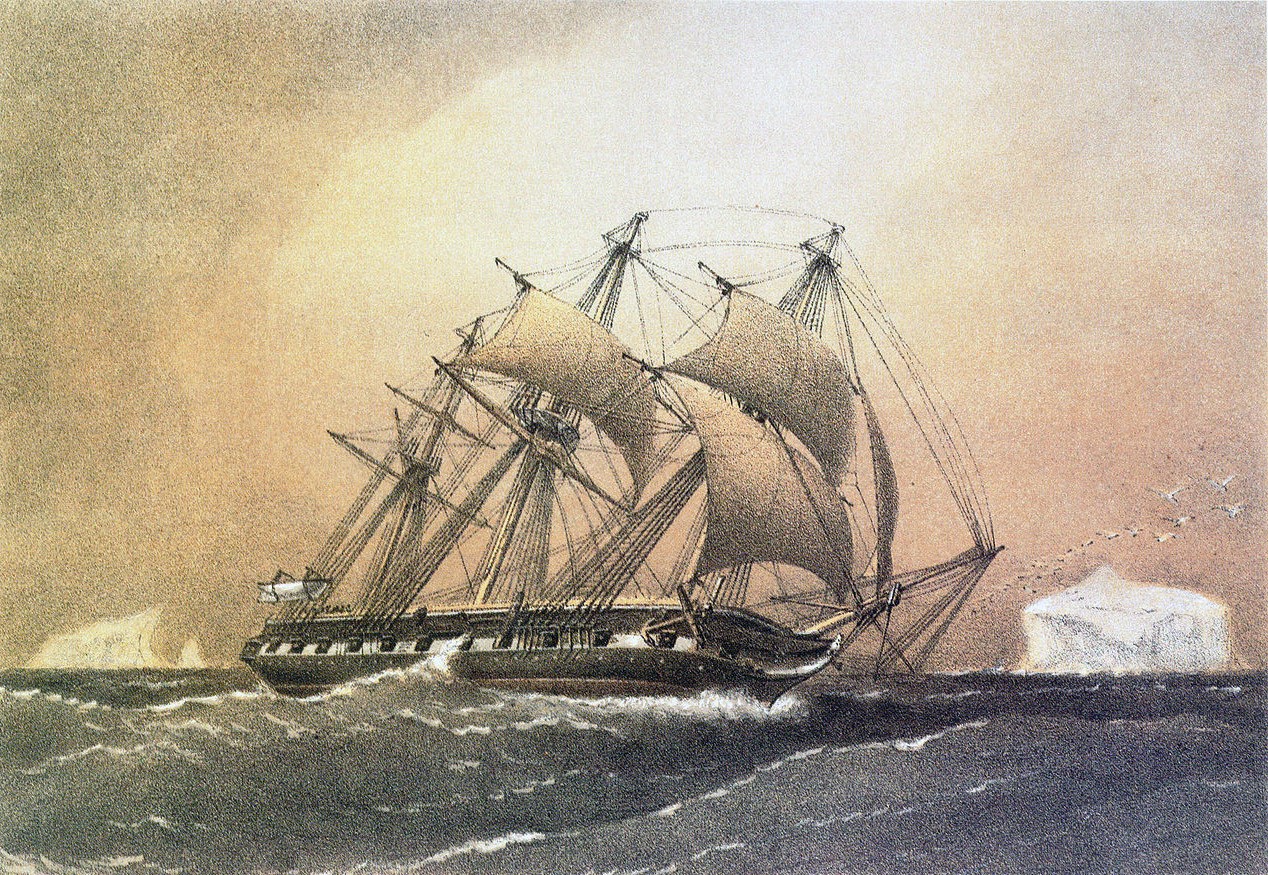
HMS Challenger Corvette, painted by William Frederick Mitchell in 1872[19]
The history of this crazy project is older than you might think. As early as 1870, the HMS Challenger, a Royal Navy steam corvette, carried out the first mining analysis of the seabed[20]. It was designed as a warship and then rebuilt for the occasion. The expedition plies the seas for a thousand days, covers more than 68,000 nautical miles and gathers an enormous amount of information on the marine environment. Numerous biological organisms, many of which are unknown, are cataloged; Data on temperatures, currents, water chemistry and seabed deposition are collected. The scientific results of the trip will then be published in a report of 50 volumes and 29,500 pages, the compilation of which will take 23 years[21].
The final report talks about a collection of interesting sediments: formations called “nodules” that lie on the ocean floor and contain high levels of various metals such as zinc, iron, silver and gold[22]. . But it is also described that the accumulation of these metals is impossible with the means available at the time. The first in-depth study of nodules and how they might be brought to the surface is that of John L. Mero in 1965[23], in which the richness and variety of available minerals, their distribution and arrangement on the seabed and finally the geography of the deposits is analyzed[24]. The book is still considered a milestone: it is the first time that the commercial use of these deposits is presented in detail[25].
From then on, studies and explorations followed one another. It turns out that in addition to nodules, hydrothermal vents present in underwater volcanic areas are also a great potential source: many substances expelled from vents from the bowels of the earth consist of copper, zinc, gold and money. These last two precious metals in particular appear to be in abundance beyond any previous assessment[26]. Then we start to study and build extraction mechanisms adaptable to the extreme conditions of the seabed. These are depths of several nautical miles where the pressure is very high and the area is impenetrable to light. Ships are needed that are stationed on the high seas for months, subjected to sudden changes in surface currents and exposed to a variety of harsh weather conditions.
Once one has overcome the rocks of the depths, mineral extraction is relatively easy: most of these raw materials lie on the seabed and look like small rounded stones with a maximum diameter of 40mm – polymetallic nodules[27]. Even removing debris near hydrothermal vents, like manganese crusts that have formed on the surface of sea mountains, is technically straightforward: just scrape it off a few inches with special underwater harrows[28].
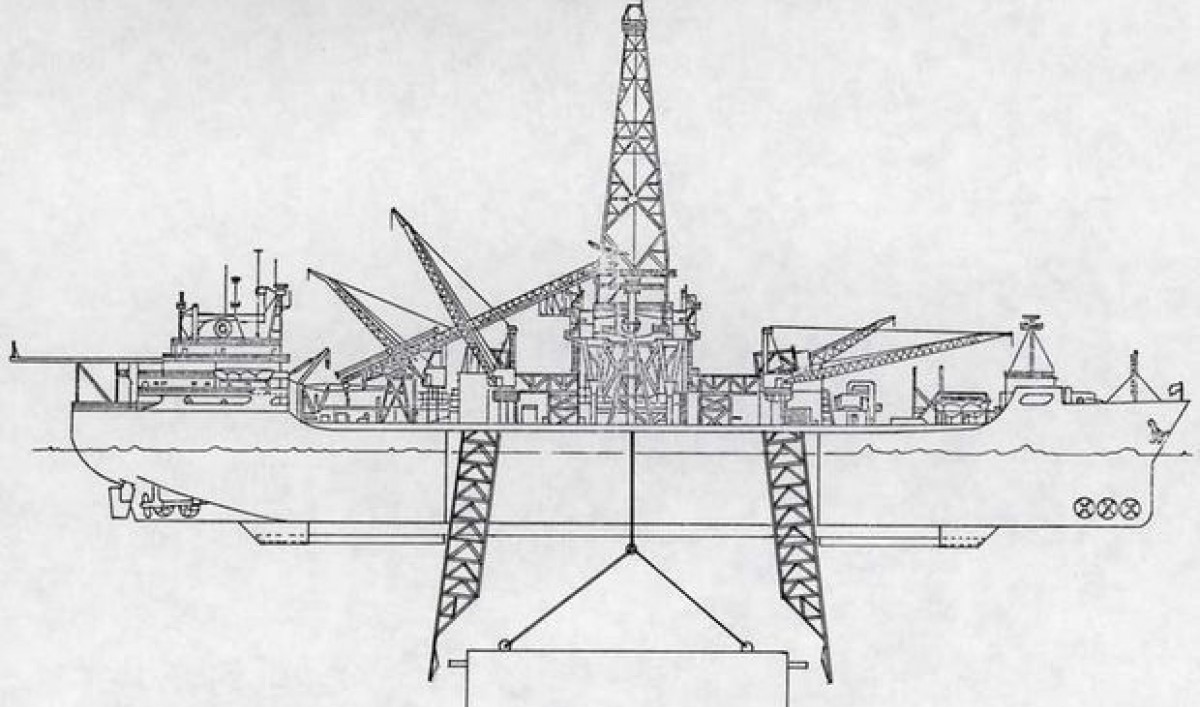
A drawing from the American Society of Mechanical Engineers depicting the Hughes Glomer Explorer[29]
The search for minerals on the seabed is first and foremost a purely military affair: after several unsuccessful attempts by the Russian Navy, the US government persuaded billionaire Howard Hughes to fund a seabed scan and use, as project manager, a CIA officer, David Sharp[30].
At a cost of more than half a billion dollars and several years of secrecy, the Hughes Glomar Explorer (HGE) – a mechanical monster taken from the images of the James Bond films – entered the practical phase of experimentation in 1974. and ran into a thousand of the then unsolvable problems: HGE only works when the sea is calm, only when the temperatures are warm, and since these are experiments in extraterritorial waters, each act of HGE is followed by six Soviet warships ready to intervene to steal secrets or to avoid any military danger[31]. Rightly so, because the only real activity HGE ever undertook was to identify, recover, and investigate sunken Soviet nuclear submarines[32].
In the early 1970s, a dozen companies got together to get serious. In a New York Times article from July 17, 1977, we read: “The companies involved in deep sea mining are American, British, French, Belgian, German, Dutch, Australian and Japanese[33]“. Then come the names of all the major multinational military and oil companies of the time, none excluded: “The simplest of the systems under development is the John L. Mero full-length bucket, a series of one-ton hoppers, 16,000 meters four inches of thick rope. The line that hangs between two ships is pulled slowly so that each bucket drags along the ground and collects the nodules”[34].
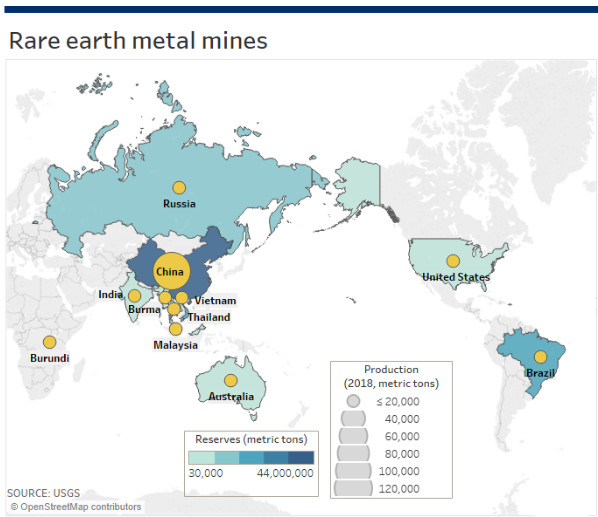
Global production of rare minerals for renewable energy, machinery and military industries in 2018[35]
Mero is also keen to establish universal rules for authorizing the use of the seabed – especially in extraterritorial waters – and in 1970 he published his article “A Legal Regime for Deep Seas Mining“, published by the University of San Diego, which will form the basis of the debate between nation-states and mining will be[36]. His thesis is clear: the exploitation of the ocean must give everyone the possibility of exploiting strategic minerals like cobalt, manganese, nickel and copper, and developing countries must have priority in the granting licenses[37].
Exploitation can only be allowed if the techniques are not destructive (as in the years Mero wrote that it would have been) and their collection is economically advantageous and not just the answer to a strategic question (military oligopoly or market). The basis for its use is to be a development and improvement of the treaty which was signed by 40 nations in Geneva in 1958 and is known as the Convention on the Continental Platform. Under this agreement, ownership of the license for use in international waters preferably rests with a consortium of neighboring countries in an ocean area[38]. To ensure compliance with these rules, John L. Mero proposes the creation of a United Nations agency acting as a leasing concessionaire: the ocean belongs to everyone, its use can only be granted for limited periods[39].
The birth of the International Seabed Authority (ISA)

August 17, 1967: Arvid Pardo addresses the United Nations General Assembly[40]
Things get serious: before a mad “gold rush” begins, the Ambassador of Malta, Arvid Pardo[41], delivers a speech to the First Committee of the United Nations General Assembly in the summer of 1967, in which he calls for the resources of the seabed to be considered a “common heritage of mankind“, which calls for the creation of an international regulatory system to prevent technologically advanced countries from colonizing the seabed and to monopolize these resources to the detriment of developing countries[42].
Pardo urges the United Nations to develop a plan to govern the oceans. In 1970, the General Assembly adopted the Declaration of Principles on the Seabed by resolution 2749 (XXV[43]). The Assembly establishes that the mineral resources of the seabed must be considered as “the common heritage of humanity” to be developed for the benefit of the community through international mechanisms[44].
After a series of successive resolutions to update the original text, in 1994, under the United Nations Convention on the Law of the Sea (UNCLOS[45]), which entered into force on November 16, 1982, the ISA (International Seabed Authority [46]) was born as an independent organization, based in Kingston, the capital of Jamaica, whose Assembly will be made up of all countries that have joined UNCLOS (there will be 158 members[47] by the end of May 2009) and will have a structure to ensure the smooth running of the UNCLOS Mission[48].
The main official objectives of the ISA are: a) To manage the mineral resources of the international seabed area, the common heritage of humanity; b) adopt rules, regulations and procedures for carrying out activities in the region; c) promote and encourage marine scientific research in this field; d) Protection and conservation of the natural resources of the area and prevention of damage to marine flora and fauna[49]. However, it will soon become clear that the real purpose of ISAs is to manage the drafting of offshore mining permit contracts. After a shutdown of almost twenty years during which the demand for raw materials decreased around the world, we can now see a market recovery and the associated renewed interest in the reclamation of marine waters, which may have fatal consequences for the survival of life on the planet.
The areas of intervention
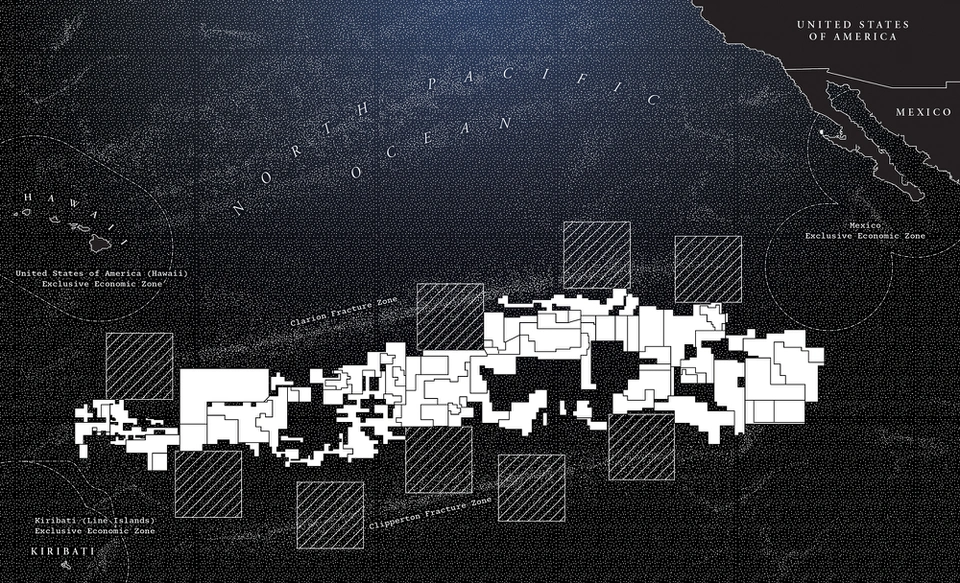
CCZ Clarion-Clipperton mining areas (white) and protected areas (striated)[50]
The ISA issues licenses in extraterritorial waters, but in the last years of the last century projects have also appeared, controlled by a benchmark country in national territorial waters[51]. With one exception, all of the exploration areas controlled by the ISA are located in the Clarion-Clipperton Zone (CCZ): an abyssal plain that stretches 4.5 million square kilometers between Hawaii and Mexico in the eastern Pacific. The other area is explored by India [52]in the central Indian Ocean basin[53].
Commercial mining’s exploitation has not yet started, the ISA has not yet decided on the mining rules[54]. Currently, the company has a number of 15-year exploration contracts: 30 contractors, many of which are consortia formed by national governments[55]. Companies wishing to operate in the CCZ must also be sponsored by at least one nation-state in order to receive a permit[56]. If the mining law is approved, the 30 companies will accelerate their explorations in the CCZ towards industrial mining[57].

The ISA has designated nine areas as Areas of Special Environmental Interest (API) which are currently protected from mining. These areas each cover 160,000 square kilometers and are located around the exploration permit areas. APIs have been positioned throughout the CCZ to protect and represent the full biodiversity and habitat of the region, including differences in nodule abundance, food availability, and seabed topography (including presence of seamounts)[58].
Most of the CCZ’s seabed is between 4,000 and 6,000 meters deep. The seabed is characterized by a series of underwater mountains, some of which reach depths of less than 3,000 meters[59]. For this reason, not all the metal on the ground can be mined in an economically advantageous manner. Even in the decades to come, only a very small fraction of this amount of nodules will be able to be extracted[60].
The consequences of the exploitation of the seabed
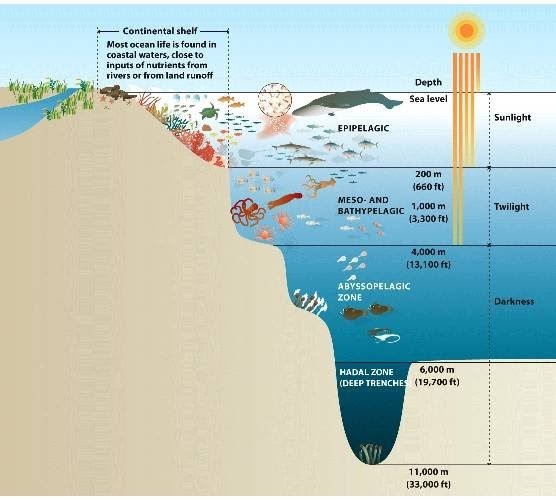
Classification of the depths of the sea[61]
At these depths, everything becomes moot: there are many known and as yet unknown species that live at depths of up to 5,500 meters in the abyssal zone, which is largely dark. It is not possible to know how they will react to commercial extraction. And the extraction of metals and minerals such as nickel, cobalt, manganese and copper, which are found in the nodules on the ocean floor, is the habitat in which these marine animals live: a habitat that would be completely destroyed[62]. A nine-year study by Dmitry M. Miljutin[63] found that “about 1 square kilometer of seabed is mined each day, or about 6,000 square kilometers over a 20-year period[64]“. A study published by James Hein, Andrea Koschinsky and Thomas Kuhn suggests that knot collectors will “crush organisms that cannot escape concealment and compact the sediment, dramatically reducing its habitability for wildlife“[65].
That’s not all. Since polymetallic nodules are a special type of oxide deposit that has no earth analog, their metallurgy has to be reinvented from scratch[66]. Because the nodules are made up of manganese oxides and complex structures of iron hydroxide, it is not possible to process them using conventional methods such as flotation, density separation or magnetic separation. The knot matrix must be completely destroyed to release the metals – using pyrometallurgy, in which the knots are melted at 1,400-1,500° C; or with hydrometallurgy, or the chemical dissolution of nodules in sulfuric or hydrochloric acid, or in extremely toxic solutions of ammonium sulphate and carbonate; microbiological treatment to dissolve microorganisms should be added[67].
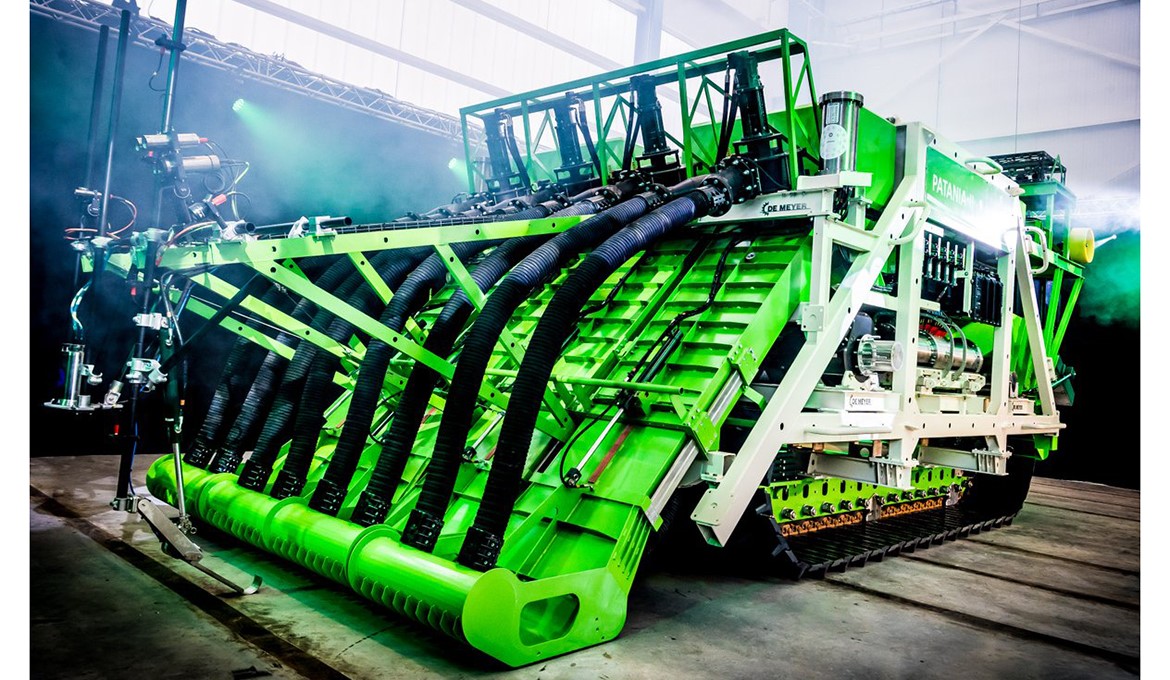
The GSR Global Sea Resources Patania II underwater mining vehicle[68]
It’s right: if the life in the abyss survives mining, it will be destroyed afterwards. The CCZ has sections located in the depth of the abyss (Hadal depth). In 2014, Timothy Shank (director of the Woods Hole Oceanographic Institution, Massachusetts[69]) led an international mission to complete the first systematic study of the Hadal ecosystem, but even Shank is unsure how mining will affect the abyss as he does not know what it contains[70].
One thing is certain: the CCZ is full of life. “This is one of the most biodiverse areas we have ever explored in the Abyssal Plains”, says Jeff Drazen, oceanographer at the University of Hawaii. Most of these creatures, Drazen explains, live on the same nodules the miners want to extract: “If you lift them off the seabed, you are removing habitat that took 10 million years to develop“. And he adds, “Many of the less mobile organisms cannot be found anywhere else on the planet[71]“. Thanks to Drazen, we know that “a Belgian team is doing tests in the CCZ and driving a vehicle on the seabed which spits out a lot of mud. We are on the verge of one of the greatest transformations humans have ever made on the face of the planet. We are going to destroy a huge living space and once it is gone it will never come back”. [72]
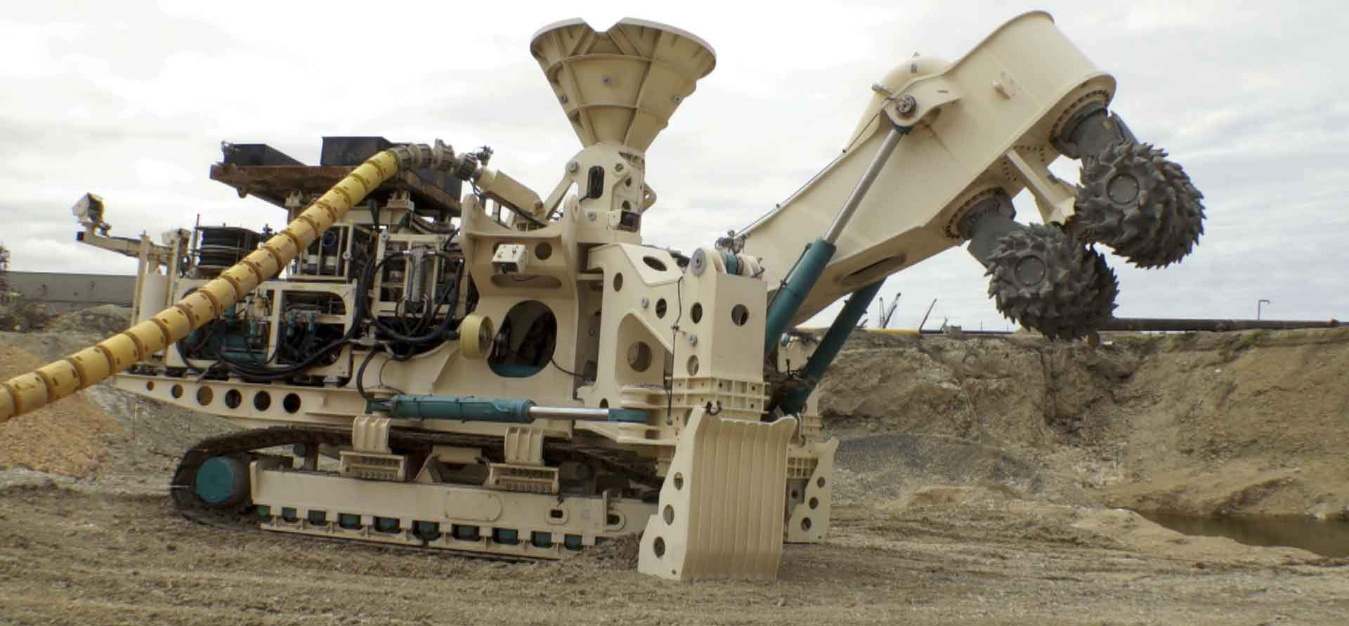
The inefficient mechanical monster developed by Nautilus Minerals[73]
Indeed … In May 2019, the Belgian company GSR Global Sea Mineral Resources, controlled by the Dutch dredging company DEME, started collecting these deposits using a prototype called Patania II. In eight days, it was sucking up nodules from an area of around 1 km2 and, thanks to the results, plans to start large-scale mining by 2026[74].
Scientists are afraid: mining creates clouds of sand that lie ten or even hundreds of meters above the seabed. “CCZ’s groundwater is the clearest of any part of the ocean,” says Craig Smith, oceanographer at the University of Hawaii. According to him, as long as the ocean remains cloudy (at least 30 years), “we will not understand the real extent of the impact of dredges[75]“. The urgency is enormous. Catherine Coumans, coordinator of the Asia Pacific MiningWatch Canada program, warns: “Mining could begin in the next two years“[76] and will destroy the abyssal habitat forever[77].
The incident in Papua New Guinea
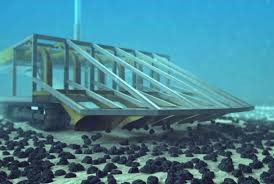
DeepGreen drilling in the seabed of Nauru’s offshore waters[78]
In 2007, a submarine with a snail plunged 1,600 meters into the sea off the coast of Papua New Guinea and reached a network of hydrothermal vents, which are home to marine life unique in the world. Operators at Canadian mining company Nautilus Minerals have started drilling the seabed for copper, gold, zinc and silver[79]. Drilling is currently on hold: in 2019, Nautilus went bankrupt before mining, and the government of Papua New Guinea, which invested in the project, is $ 140 million in debt[80]. A state-owned company, Eda Kopa, is trying to recover some of the money in court[81].
The marine environment did not fare better. Jonathan Mesulam of the Alliance of Solwara Warriors Association, who has been fighting Nautilus Minerals for years, is furious: “We are worried because mining is experimental, there are no examples in the world and Papua- New Guinea has no regulatory framework”. At this point, there is an underwater volcano that can cause a tsunami. “It has also influenced our unique shark reputation culture, which is our identity,” adds Mesulam: “Sharks are a major source of food for our people, and we hunt them by summoning them using an old technique and ritual since several centuries. When Nautilus began its exploration, the sharks left our water”[82].
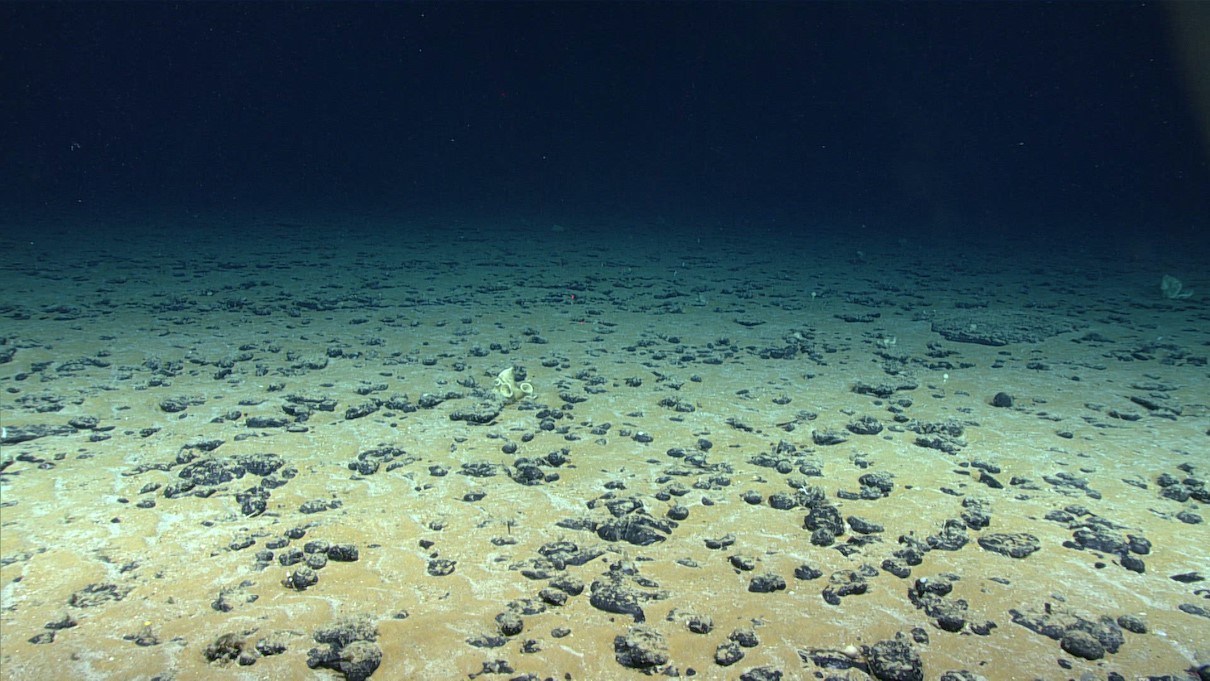
A photo of the seabed in the offshore waters off Papua New Guinea after drilling by Nautilus Minerals covered everything in sand and mud[83]
In August 2019, Fijian President Frank Bainimarama called on the United Nations “to support the call for a 10-year moratorium on seabed degradation from 2020 to 2030, which would allow a decade of adequate scientific research in our territorial waters“. Vanuatu Prime Minister Charlot Salwai was the first to support this call “to put the health of our communities first and to recognize values that go beyond economic gain“. Papua New Guinea had previously supported the deep-water mining project, but new Prime Minister James Marape has changed his mind after his country’s bad adventure with Nautilus Minerals[84].
Nauru is also one of the first supporters of the seabed mining project. DeepGreen plans to mine cobalt and other metals from an area of 75,000 km² in the CCZ area, over which the State of Nauru has obtained control. DeepGreen Metals, a Canadian company born out of the ashes of Nautilus Minerals, received a loan of $ 150 million, largely from a Swiss company (Allseas SA Châtel St. Denis), to help start the feasibility studies[85]. Nauru is a country already characterized by mines. Over 80% of the small island’s landmass was rendered uninhabitable in the 20th century by British and Australian phosphate mines[86].
Allseas is not concerned with the extraction of minerals, but with the deposit of intercontinental pipelines on the seabed – and therefore has interests that are not entirely crystalline[87] in the project. Allseas controls over 100 companies around the world[88], but does not disclose its shareholders or sales[89]. The only thing known is that Allseas is laying the seabed pipelines that connect Germany via the Skagerrak and the Gulf of Bothnia to the regions of the far north of Russia (the project called North Stream) and against which the US government proceeds with the full power of their good machine[90].
Michael Lodge and the conflicts of interest of the International Seabed Authority
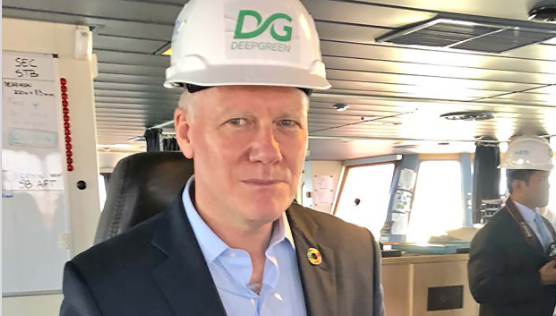
Michael W. Lodge, Director General of the International Seabed Authority ISA, wearing a DeepGreen Metals helmet[91]
The whole licensing system of the International Seabed Authority raises some questions. One of the licenses is that of the Ocean Minerals Consortium of Singapore, whose shareholders, according to ISA documents[92], are Keppel Corporation Ltd. Singapore – a multinational mineral and oil exploration company[93], and Seabed Resources Development Ltd. Langstone, which is 100% owned by the Lockheed Martin[94] military group and owns the second stake. A curious detail: Lockheed-Martin was the first military industry to have obtained a license for the CCZ, and it is also the industrial company that employs Michelle Xhsia, as director, which is also an executive of the ISA and the wife of its president Michael W. Lodge[95].
This is not the only conflict of interest within the ISA. Zambia-Canadian citizen Chapi Mwango, who works in the Lodge office, before joining ISA, he worked for Glencore-Xstrata[96] – one of Nautilus Minerals’s industrial partners in the Pacific[97]. Today, in addition to holding ISA money, Mwango is a shareholder and vice-president of PMI Jamaica[98]: a company that provides environmental impact assessments and on-demand assistance to companies wishing to obtain a license to exploitation of the seabed[99] … At the head of the ISA law firm is the Mexican diplomat Alfonso Ascencio Herrera, who is also an officer of the SEM (Servicio Exterior Mexicano) or of the military intelligence services of his country[100] – you in this role in a program of participation of China[101] and South Korea in projects exploiting the contribution to the seabed[102].
Over time, as the ISA leadership feels more confident in its sanctity, the alleged conflicts of interest increase. In December 2020, the ISA Board of Directors approved the exploration and recovery plan for Blue Minerals Jamaica Ltd. Kingston[103] and welcomed the small Caribbean nation’s decision to invest in this project[104]. It’s a shame that Blue Minerals has nothing Jamaican about it and is just an offshore company that was founded in 2019 with a capital of $ 0[105] and owned by two brokers operating in Switzerland, the Italian Romeo Spinelli and the Danish Peter Henrik Jantzen[106], who have been with Michael W. Lodge for years and participate in international conferences as ISA experts[107].
Although all the major NGOs have been fighting desperately for a decade to stop these apocalyptic plans, the United Nations is not responding, also because many nation states know that the excavations will take place in the middle of an ocean thousands of miles away. of their coasts. They show no interest in thinking about the dangerousness and the probable illegality of the whole project. Unlike the problem of global warming, the presence of plastic in the oceans and air pollution, the world population is not aware of the danger. For this reason, we will now regularly publish articles that attempt to raise awareness on this issue. Before it’s too late.
SVE002
[1] Frank Schätzing, “Der Schwarm“, Kiepenheuer & Witsch, Köln 2004
[2] https://www.isa.org.jm/mining-code/regulations
[3] https://www.statista.com/statistics/268789/countries-with-the-largest-production-output-of-lithium/
[4] https://www.mckinsey.com/industries/oil-and-gas/our-insights/metal-mining-constraints-on-the-electric-mobility-horizon#
[5] https://sites.nationalacademies.org/cs/groups/pgasite/documents/webpage/pga_059587.pdf
[6] https://geology.com/articles/rare-earth-elements/
[7] https://www.reuters.com/article/us-congo-mining-insight-idUSKCN1UC0BS
[9] https://unctad.org/system/files/official-document/ditccom2019d5_en.pdf
[10] https://about.bnef.com/blog/china-dominates-the-lithium-ion-battery-supply-chain-but-europe-is-on-the-rise/
[11] https://www.cnbc.com/2019/06/14/us-china-trade-war-chinas-rare-metal-dominance-explained.html
[12] https://www.trtworld.com/magazine/china-s-control-of-rare-minerals-has-the-power-to-disrupt-the-us-economy-26845
[13] https://www.usgs.gov/news/interior-releases-2018-s-final-list-35-minerals-deemed-critical-us-national-security-and
[14] https://jnlwp.defense.gov/Press-Room/Fact-Sheets/Article-View-Fact-sheets/Article/577989/active-denial-technology/
[15] http://www.rareearthassociation.org/DoE%20Critical%20Materials%20Strategy%20Report.pdf
[16] https://geology.com/articles/rare-earth-elements/ ; https://www.isa.org.jm/news/isa-secretary-general-welcomes-growing-interest-deep-seabed-mining-positive-development
[17] https://mcgroup.co.uk/researches/manganese
[18] https://www.mining-technology.com/features/featuremined-into-extinction-is-the-world-running-out-of-critical-minerals-5776166/
[19] https://divediscover.whoi.edu/history-of-oceanography/the-challenger-expedition/
[20] http://www.bbc.com/travel/story/20200719-hms-challenger-the-voyage-that-birthed-oceanography
[21] https://oceanexplorer.noaa.gov/explorations/03mountains/background/challenger/challenger.html
[22] https://pubs.geoscienceworld.org/msa/elements/article/14/5/301/559105/Deep-Ocean-Mineral-Deposits-Metal-Resources-and ; https://epic.awi.de/id/eprint/38636/2/challenger-report_1891.pdf
[23] John L. Mero, “The mineral resources of the sea”, Elsevier Publishing Company, Amsterdam 1965
[24] https://core.ac.uk/download/pdf/42904622.pdf
[25] https://edgeeffects.net/seabed-mining/
[26] https://www.pewtrusts.org/en/research-and-analysis/fact-sheets/2019/09/deep-sea-mining-on-hydrothermal-vents-threatens-biodiversity
[27] https://news.mongabay.com/2020/06/deep-sea-mining-an-environmental-solution-or-impending-catastrophe/
[28] https://news.mongabay.com/2020/06/deep-sea-mining-an-environmental-solution-or-impending-catastrophe/
[29] https://www.pri.org/stories/2015-09-07/ship-built-cias-most-audacious-cold-war-mission-now-headed-scrapyard
[30] https://www.bbc.co.uk/news/resources/idt-sh/deep_sea_mining
[31] https://www.bbc.co.uk/news/resources/idt-sh/deep_sea_mining
[32] https://www.pri.org/stories/2015-09-07/ship-built-cias-most-audacious-cold-war-mission-now-headed-scrapyard
[33] https://www.nytimes.com/1977/07/17/archives/mining-the-wealth-of-the-ocean-deep-multinational-companies-are.html
[34] https://www.nytimes.com/1977/07/17/archives/mining-the-wealth-of-the-ocean-deep-multinational-companies-are.html
[35] https://clearworld.us/renewable-energy-requires-rare-earth-minerals-china-holds-most-of-them/
[36] https://digital.sandiego.edu/cgi/viewcontent.cgi?article=2380&context=sdlr
[37] https://legal.un.org/ilc/texts/instruments/english/conventions/8_1_1958_continental_shelf.pdf
[38] https://legal.un.org/ilc/texts/instruments/english/conventions/8_1_1958_continental_shelf.pdf
[39] https://digital.sandiego.edu/cgi/viewcontent.cgi?article=2380&context=sdlr, pages 499-500
[40] https://legal.un.org/avl/ha/uncls/uncls.html
[41] https://en.wikipedia.org/wiki/Arvid_Pardo ; https://legal.un.org/avl/ha/uncls/uncls.html
[42] https://www.un.org/depts/los/convention_agreements/texts/pardo_ga1967.pdf
[43] https://cil.nus.edu.sg/wp-content/uploads/formidable/18/1970-UN-General-Assembly-Resolution-2749.pdf
[44] https://www.cambridge.org/core/journals/international-organization/article/in-search-of-an-ocean-regime-the-negotiations-in-the-general-assemblys-seabed-committee-19681970/F2782DB29E419F35B3F3A2DA624DF71C
[45] https://www.un.org/Depts/los/convention_agreements/texts/unclos/UNCLOS-TOC.htm
[47] https://isa.org.jm/files/files/documents/sb-15-17.pdf
[48] https://www.grida.no/resources/6311
[49] https://isa.org.jm/files/documents/EN/30Ann/SG-Presentation.pdf
[50] https://www.theatlantic.com/magazine/archive/2020/01/20000-feet-under-the-sea/603040/
[51] https://news.mongabay.com/2020/06/deep-sea-mining-an-environmental-solution-or-impending-catastrophe/
[52] https://www.isa.org.jm/about-isa
[53] https://news.mongabay.com/2020/06/deep-sea-mining-an-environmental-solution-or-impending-catastrophe/
[54] https://www.dw.com/en/whats-the-science-on-deep-sea-mining-for-rare-metals/a-53686045
[55] https://www.dw.com/en/whats-the-science-on-deep-sea-mining-for-rare-metals/a-53686045
[56] https://news.mongabay.com/2020/06/deep-sea-mining-an-environmental-solution-or-impending-catastrophe/
[57] https://www.theatlantic.com/magazine/archive/2020/01/20000-feet-under-the-sea/603040/
[58] https://oceanexplorer.noaa.gov/explorations/18ccz/background/mining/mining.html
[59] https://www.isa.org.jm/documents/geological-model-polymetallic-nodule-deposits-clarion-clipperton-fracture-zone
[60] https://www.nature.com/articles/s43017-020-0027-0?utm_source=other&utm_medium=other&utm_content=null&utm_campaign=JRCN_2_DD01_CN_NatureRJ_article_paid_XMOL
[61] https://candlepozt.com/2018/01/12/5-mysterious-things-about-the-mariana-trench/
[62] https://www.dw.com/en/whats-the-science-on-deep-sea-mining-for-rare-metals/a-53686045
[63] https://www.researchgate.net/publication/280735258_Metody_landsaftnyh_issledovanij_i_ocenki_zapasov_donnyh_bespozvonocnyh_i_vodoroslej_morskoj_pribreznoj_zony
[64] https://www.dw.com/en/whats-the-science-on-deep-sea-mining-for-rare-metals/a-53686045
[65] Hein, J.R., Koschinsky, A. & Kuhn, T. Deep-ocean polymetallic nodules as a resource for critical materials. Nat Rev Earth Environ 1, 158–169 (2020). https://doi.org/10.1038/s43017-020-0027-0
[66] https://www.nature.com/articles/s43017-020-0027-0?utm_source=other&utm_medium=other&utm_content=null&utm_campaign=JRCN_2_DD01_CN_NatureRJ_article_paid_XMOL
[67] https://www.nature.com/articles/s43017-020-0027-0?utm_source=other&utm_medium=other&utm_content=null&utm_campaign=JRCN_2_DD01_CN_NatureRJ_article_paid_XMOL
[68] https://www.seatools.com/projects/subsea-mining-vehicle-patania-ii/
[69] https://www.theatlantic.com/magazine/archive/2020/01/20000-feet-under-the-sea/603040/
[70] https://www.theatlantic.com/magazine/archive/2020/01/20000-feet-under-the-sea/603040/
[71] https://www.theatlantic.com/magazine/archive/2020/01/20000-feet-under-the-sea/603040/
[72] https://news.mongabay.com/2020/06/deep-sea-mining-an-environmental-solution-or-impending-catastrophe/
[73] https://www.bbc.co.uk/news/resources/idt-sh/deep_sea_mining
[74] https://www.dhyg.de/images/hn_ausgaben/HN095.pdf
[75] https://www.nature.com/articles/d41586-019-00757-y
[76] https://miningwatch.ca/blog/2019/10/30/mining-deep-sea-stories-suckers-and-corporate-capture-un
[77] https://news.mongabay.com/2020/06/deep-sea-mining-an-environmental-solution-or-impending-catastrophe/
[78] https://miningir.com/deepgreen-secures-150m-funding-for-deep-sea-mining/
[79] https://www.bbc.co.uk/news/resources/idt-sh/deep_sea_mining
[80] https://miningwatch.ca/news/2019/11/22/where-does-canada-stand-deep-sea-mining ; https://www.savingseafood.org/news/conservation-environment/deep-sea-mining-an-environmental-solution-or-impending-catastrophe/ ; https://news.mongabay.com/2020/06/deep-sea-mining-an-environmental-solution-or-impending-catastrophe/
[81] https://www.theguardian.com/world/2019/sep/16/collapse-of-Papua Nuova Guinea-deep-sea-mining-venture-sparks-calls-for-moratorium
[82] https://miningwatch.ca/news/2019/11/22/where-does-canada-stand-deep-sea-mining ; https://www.savingseafood.org/news/conservation-environment/deep-sea-mining-an-environmental-solution-or-impending-catastrophe/ ; https://news.mongabay.com/2020/06/deep-sea-mining-an-environmental-solution-or-impending-catastrophe/
[83] https://news.mongabay.com/2020/06/deep-sea-mining-an-environmental-solution-or-impending-catastrophe/
[84] https://www.theguardian.com/world/2019/sep/16/collapse-of-Papua Nuova Guinea-deep-sea-mining-venture-sparks-calls-for-moratorium
[85] https://deep.green/deepgreen-acquires-third-seabed-contract-area-to-explore-for-polymetallic-nodules/ ; https://miningir.com/deepgreen-secures-150m-funding-for-deep-sea-mining/
[86] https://www.theguardian.com/world/2019/sep/16/collapse-of-Papua Nuova Guinea-deep-sea-mining-venture-sparks-calls-for-moratorium
[87] https://allseas.com/activities/
[88] https://opencorporates.com/companies?jurisdiction_code=&q=allseas&utf8=%E2%9C%93
[89] Allseas Fabrication Holding BV Delft; Allseas Group SA Châtel-Saint-Denis
[90] https://www.arcinfo.ch/articles/monde/firme-suisse-touchee-par-une-sanction-de-trump-contre-un-gazoduc-russe-l-ue-s-oppose-a-l-ingerence-americaine-891042
[92] https://isa.org.jm/files/files/documents/Public%20information%20on%20contracts%20OMS.pdf
[93] https://www.marketscreener.com/quote/stock/KEPPEL-CORPORATION-LIMITE-6492087/company/
[94] 2018.12.31 Seabed Resources Development Ltd. Langstone, page 17
[95] https://www.linkedin.com/in/tsweichen/
[96] https://www.linkedin.com/in/chapi-mwango-pmp-23b8a95b/?originalSubdomain=jm
[97] https://safety4sea.com/wp-content/uploads/2019/07/Mining-Watch-Canada-Deep-Sea-mining-campaign-London-mining-network-Why-the-rush-2019_07.pdf, page 11; https://financialpost.com/commodities/mining/deepgreen-strikes-deal-with-glencore-for-undersea-mining-metals ; https://www.reuters.com/article/china-mining-cobalt-idUSL8N1XN6JD ; https://www.proactiveinvestors.co.uk/companies/news/253732/fairfax-market-report-including-glencore-ormonde-mining-and-nautilus-minerals–5089.html ; http://astrolabio.amicidellaterra.it/node/2221
[98] https://pmijamaica.org/2021/01/02/vice-president-finance/
[99] https://pmijamaica.org/about-us/
[100] https://www.gob.mx/sre/prensa/el-mtro-alfonso-ascencio-herrera-es-electo-a-la-comision-juridica-y-tecnica-de-la-autoridad-internacional-de-los-fondos-marinos-periodo-2017-2021
[101] http://webcache.googleusercontent.com/search?q=cache:ToUq6oUHFkQJ:www.comra.org/en/2017-02/07/content_9321758.htm+&cd=19&hl=it&ct=clnk&gl=it&client=firefox-b-d
[102] http://www.dila-korea.org/dilakorea/gallery_view_06.html ; file:///C:/Users/Paolo/AppData/Local/Temp/Alfonso%20Ascencio%20Herrera.pdf
[103] https://isa.org.jm/files/files/documents/ISBA_26_C_L.5-2014638E.pdf
[104] https://isa.org.jm/files/files/documents/Jamaica_2.pdf
[105] Blue Minerals Jamaica Ltd. Kingston
[106] Jantzen & Spinelli Capital Power GmbH Winterthur; Jantzen & Spinelli Capital Power Ltd. London; Blue Minerals Jamaica Ltd. Kingston
[107] Greenpeace Lodge Spinelli, pages 10-13; WEF Lodge Spinelli, page 9; https://www.greenpeace.de/sites/www.greenpeace.de/files/publications/deep-trouble-report-greenpeace.pdf, page 10




Leave a Reply